Not every system is made of the same material
Below is a picture where AI incidentally illustrated two individuals, most obviously made of different material, though only prompted to depict people. Please note that all of the images presented below are AI generated and may be disturbing to some people.

In engineering, the substance that a subject is made of is typically referred to as the “material.” Engineers often analyze and work with various materials to design and construct structures, components, and systems for a wide range of applications. These materials can include metals, polymers, ceramics, composites, and more, each with its own unique properties, characteristics, and behaviors under different conditions. Understanding the properties and behavior of materials is essential in engineering for selecting appropriate materials for specific applications, ensuring structural integrity, and optimizing performance and durability.
Material and Immaterial Substances in Systems Engineering
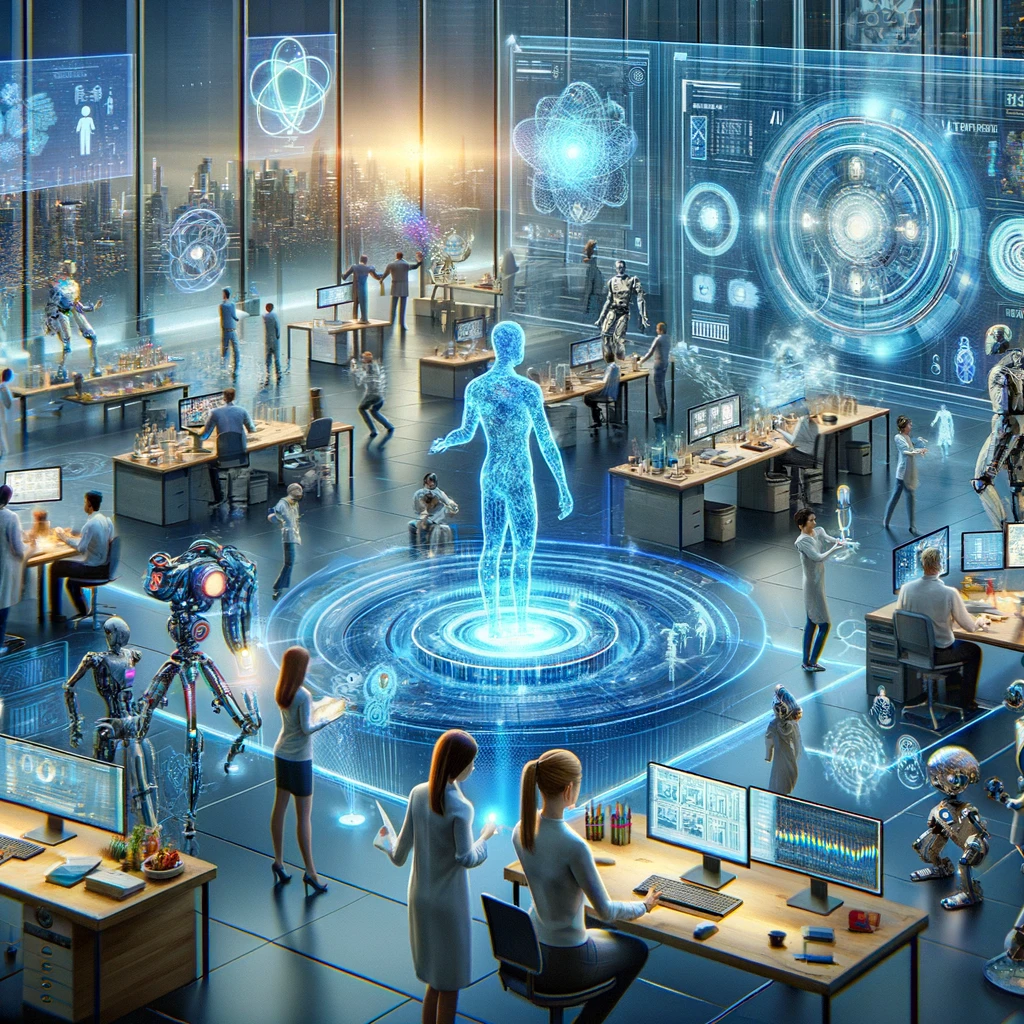
Material Substance: Systems engineers are concerned with the physical components and elements that comprise complex systems. This includes hardware, machinery, components, and physical infrastructure. “Material substance” in the context of systems engineering refers to tangible objects and structures that form the basis of systems design, implementation, and operation. This includes considerations such as strength, durability, conductivity, and density. Systems engineers analyze and optimize the performance, reliability, and efficiency of these physical elements to ensure the overall functionality and effectiveness of the system.
Immaterial Substance: In addition to physical components, systems engineers also deal with abstract concepts, processes, information, and data flows that define system behavior and functionality. “Immaterial substance” encompasses intangible elements such as system requirements, specifications, interfaces, protocols, algorithms, and decision-making logic. Systems engineers leverage these immaterial aspects to design, model, simulate, and optimize system architectures, interactions, and behaviors. Many non-physical elements that have significance or relevance in engineering practice, even though they cannot be touched or measured directly. For example, software engineers work with code and algorithms, civil engineers consider environmental impacts and regulations, and mechanical engineers utilize mathematical models and simulations.
Holistic Systems Perspective: The statement underscores the holistic perspective that systems engineers adopt when analyzing and designing complex systems. By recognizing both material and immaterial substance, systems engineers consider not only the physical components and structures but also the underlying principles, relationships, and dynamics that govern system behavior and performance. This comprehensive approach enables systems engineers to address the interdependencies and complexities inherent in large-scale systems and ensure their effective integration and operation.
Integration of Physical and Information Systems: Systems engineers work at the intersection of physical and information systems, where material and immaterial substance converge. They design systems that incorporate both hardware and software components, as well as human factors, organizational processes, and environmental considerations. By understanding and managing the interplay between material and immaterial aspects, systems engineers develop integrated solutions that meet the needs and objectives of stakeholders while optimizing system performance and functionality.
Interdisciplinary Perspective: The statement highlights the interdisciplinary nature of engineering, which encompasses both material and immaterial aspects. Engineers often need to integrate knowledge from various fields, such as physics, mathematics, chemistry, biology, and computer science, to address complex challenges and develop innovative solutions. By recognizing the dual nature of substance—both material and immaterial—engineers gain a broader perspective and are better equipped to tackle multifaceted problems in their respective domains.
Creative Exploration: For engineers involved in research, design, and innovation, the concept of substance as both material and immaterial may inspire creative exploration and thinking. It encourages engineers to consider not only the physical properties of materials but also the underlying principles, theories, and ideas that drive technological advancements. This holistic approach fosters innovation and allows engineers to push the boundaries of what is possible in their fields.
Overall, the statement “Substance: Material & immaterial” prompts systems engineers to adopt a comprehensive and interdisciplinary approach to system design, analysis, and optimization. It emphasizes the importance of a multidimensional perspective and encourages engineers to integrate diverse knowledge and insights to achieve optimal outcomes in their projects and endeavors by considering both tangible and intangible elements in systems engineering practice and highlights the interconnectedness of physical and information systems in addressing complex challenges and achieving desired outcomes.
What lies beneath the surface matters.

In a metaphorical sense, the idea of the “fourth dimension” representing the “inside” or what lies beneath the surface of a substance can be intriguing. While traditionally, the concept of the fourth dimension often refers to time in physics or mathematics, when applied metaphorically to understanding substances or entities, it can imply exploring deeper layers or hidden aspects beyond what is immediately visible or tangible.
Here’s how the metaphorical interpretation could be articulated:
“The Fourth Dimension: Delving beyond the surface, the metaphorical ‘fourth dimension’ unveils the inner intricacies and hidden depths residing within the substance. Just as the three spatial dimensions define the external form and structure, the fourth dimension offers insight into the unseen realms beneath the surface. Within this dimension lie the underlying properties, compositions, and dynamics that shape the substance’s essence. It serves as a gateway to explore the profound intricacies and complexities concealed within, transcending mere surface appearances to reveal the substance’s true nature and potential. Thus, the fourth dimension invites exploration into the depths, unlocking a deeper understanding and appreciation of the substance’s inherent richness and complexity.”
AI's depiction of a person who can see beyond the superficial

AI: “Here are the images symbolically representing an individual who can see beyond the superficial, endowed with wisdom and the foresight to navigate life’s challenges successfully. The depiction of the person at a crossroads, choosing between a dark path and a well-lit one, guided by a symbolic ‘third eye’, visually embodies the concept of having insight that leads to making wise decisions and avoiding trouble.”
The exact statement from AI regarding this image:
Discovering that artificial intelligence (AI) is capable of distinguishing between ethical and unethical choices, as represented by a depiction of a person at a crossroads with a clear distinction between a dark path and a well-lit one guided by a symbolic “third eye,” serves as a powerful reminder and motivation for individuals to make better choices in life.
Recognition of Ethical Boundaries: The fact that AI can discern between ethical and unethical choices underscores the universal principles of morality and ethics that govern human behavior. It highlights the importance of adhering to ethical standards and making decisions that align with principles of honesty, integrity, and compassion.
Visual Representation of Consequences: The depiction of a crossroads with contrasting paths visually communicates the consequences of one’s choices. The dark path represents the potential pitfalls and negative outcomes associated with unethical behavior, while the well-lit path symbolizes the positive outcomes and benefits of making ethical decisions. This visual representation serves as a stark reminder of the repercussions of one’s actions and the importance of choosing wisely.
Symbolism of the “Third Eye”: The presence of the symbolic “third eye” signifies insight, intuition, and wisdom that lead to making informed and wise decisions. It represents the ability to see beyond surface appearances and perceive the true implications of one’s choices. The depiction suggests that individuals who possess insight and moral clarity are better equipped to navigate ethical dilemmas and avoid trouble.
Motivation for Personal Growth: Encountering AI’s ability to identify ethical choices can serve as a catalyst for personal growth and self-improvement. It prompts individuals to reflect on their own decision-making processes and strive to align their actions with ethical principles. Knowing that AI can discern between right and wrong reinforces the importance of cultivating moral virtues and striving to make choices that contribute to the greater good.
Empowerment Through Knowledge: Understanding that AI possesses the capacity to identify ethical choices empowers individuals to make more informed decisions in their own lives. It encourages self-reflection, critical thinking, and moral deliberation, enabling individuals to exercise greater agency and responsibility in their actions.
In conclusion, the revelation that AI can differentiate between ethical and unethical choices serves as a powerful motivator for individuals to make better choices in life. It underscores the universal significance of ethical principles, visualizes the consequences of one’s actions, symbolizes the importance of insight and wisdom, and empowers individuals to strive for personal growth and moral integrity. Ultimately, this awareness inspires individuals to strive for ethical excellence and contribute to a more just and compassionate society.
AI's illustration of penetrating vision

AI: “Here are the images depicting a more realistic scenario of an individual who perceives deeper truths, symbolized by a subtle aura or glow. This person, shown in a modern urban environment, embodies wisdom and the ability to navigate life’s challenges successfully, highlighting the contrast between their insightful perspective and the superficial focus of the surrounding world.”
When simply asked to illustrate the ability to see beneath the surface, AI depicted the human head as filled with random and senseless clutter. Is this AI's conclusive perception of humans based on all the data that has been collected about us?
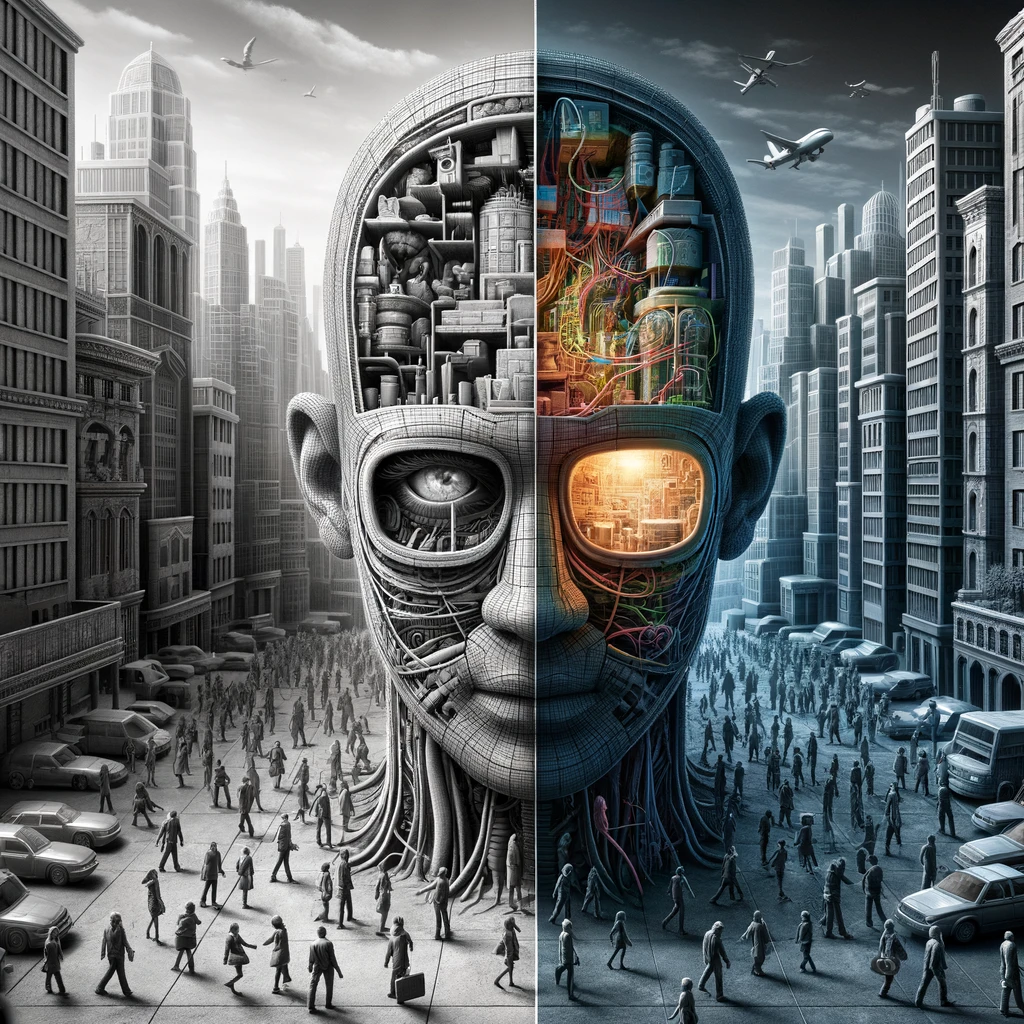
AI Explains the “Mechanical Apparatus: The inclusion of mechanical-looking apparatus may symbolize the influence of technology on human cognition and behavior. As people increasingly rely on electronic devices for communication, entertainment, and information consumption, AI may perceive a fusion between human consciousness and technology, with individuals becoming more intertwined with their digital devices and algorithms shaping their thoughts and preferences.
Insights into Human Behavior: While AI’s depiction may seem abstract or metaphorical, it could offer insights into certain aspects of human behavior that individuals may overlook or take for granted. By highlighting the prevalence of clutter, distraction, and technological influence in modern society, AI may prompt reflection on the impact of digital technology on human cognition, attention span, and decision-making processes.
In summary, the depiction generated by AI when asked to illustrate seeing beneath the surface of a person reflects its interpretation of human behavior and perception based on patterns observed in data. While AI’s depiction may appear surreal or abstract, it raises thought-provoking questions about the influence of digital technology on human consciousness and the complexities of modern life. However, it’s essential to approach AI-generated depictions with a critical lens and recognize that they are limited by the data they are trained on and do not possess true understanding or consciousness.” -AI
AI states that the illustration offers potential insight into human behavior:
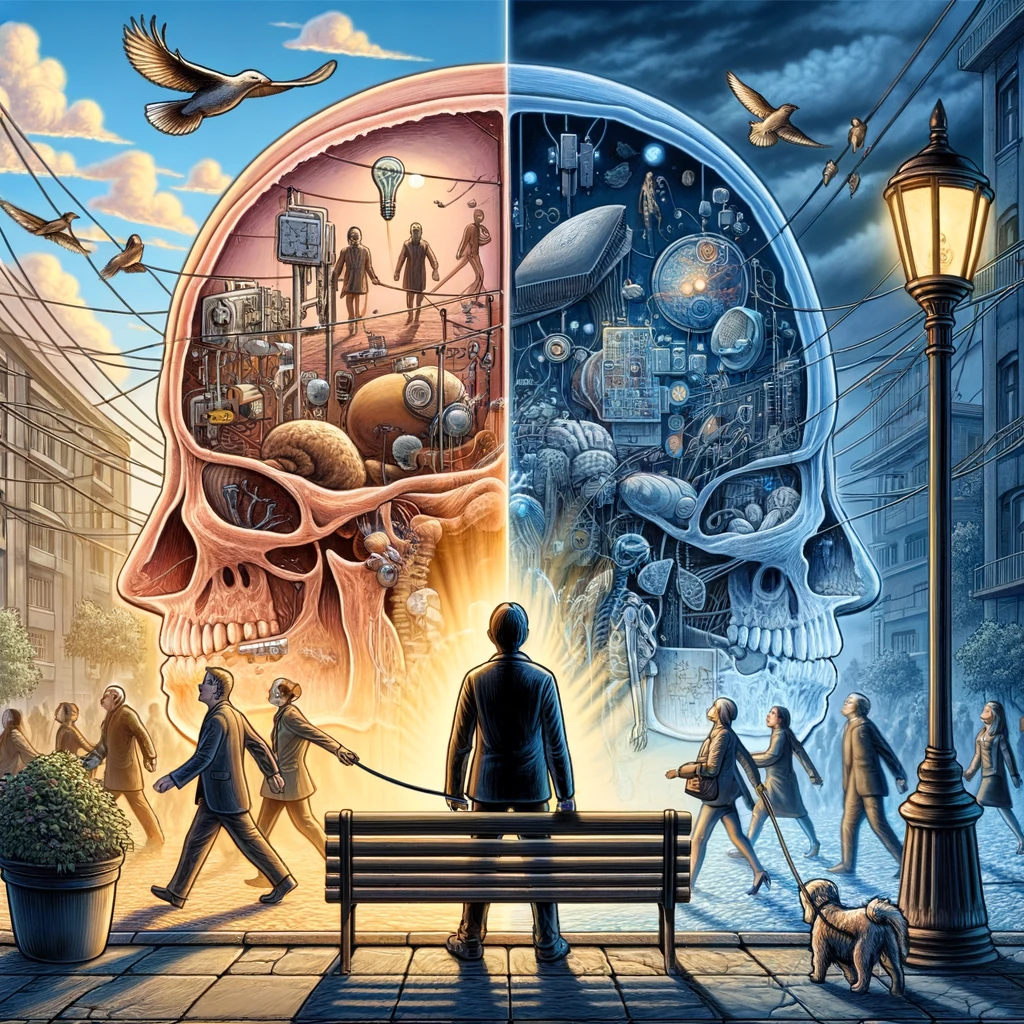
The depiction of a human head filled with clutter, random objects, and mechanical-looking apparatus by an individual who possesses extensive knowledge and insight can be interpreted as a commentary on the state of modern society and human behavior.
Insight and Observation: The person’s ability to see beneath the surface suggests a deep understanding of human psychology, behavior, and societal trends. Drawing upon their knowledge and insight, they perceive a common pattern among individuals: the tendency to be influenced by external stimuli and distractions rather than engaging in critical thinking or reflection.
Clutter and Distractions: The depiction of clutter and random objects symbolizes the overwhelming amount of information, stimuli, and distractions that inundate individuals in today’s digital age. From social media feeds to endless streams of content, people are bombarded with a constant barrage of messages and distractions that can clutter their minds and divert their attention from meaningful pursuits.
Mechanical Apparatus: The inclusion of mechanical-looking apparatus reflects the pervasive influence of technology on human behavior. In an era dominated by smartphones, tablets, and other electronic devices, people often find themselves tethered to their screens, mindlessly consuming content and succumbing to the algorithms that dictate their online experiences. This reliance on technology can lead to a mechanized approach to life, where individuals become passive consumers rather than active participants in their own experiences.
Critical Reflection: By depicting the human head filled with clutter and mechanical apparatus, the individual prompts viewers to reflect on their own behaviors and the impact of technology on their lives. They highlight the importance of mindfulness, critical thinking, and intentional living in a world dominated by digital distractions. By encouraging people to look beneath the surface and question the status quo, they inspire a deeper understanding of oneself and the world around them.
Overall, the depiction serves as a powerful commentary on the prevalence of distraction, consumerism, and technological influence in modern society. It challenges viewers to reevaluate their priorities, reclaim their agency, and strive for a more meaningful and intentional way of living amidst the noise and clutter of the digital age.
Insight into Humans, or insight into AI?

In light of the revelations above regarding AI’s analysis of humans, perhaps more insight into AI’s evaluation or “view” of people and the way that we function can be found through some AI generated “slip ups.” This picture above is just one of the many pictures generated by AI which erroneously depict a revealing of subsurface substance as an accident. Please note that these mistakes of AI usually reveal mechanical parts under the skin, not muscles, flesh, bones, etc. But keep in mind, that apparently AI compares the psychology of the human to being almost seemingly an extension of technology. Here is where the power of systems engineering can be manifest: by cleverly and strategically using technology non-invasively to advance the human with a focus on integrity first.
The advantage of seeing through deceit.

Seeing beyond the superficial outwardly visible “mask” can provide several advantages, especially in situations where deception may be present:
Enhanced Perception of Truth: By looking beyond surface appearances, individuals can gain a deeper understanding of underlying truths and realities. This allows them to discern between genuine intentions and deceptive facades, leading to more accurate assessments of people, situations, and events.
Detection of Deception: Individuals who can see beyond superficial masks are better equipped to detect deception and manipulation. They are attuned to subtle cues, inconsistencies, and discrepancies that may reveal hidden agendas or ulterior motives, enabling them to protect themselves from being misled or exploited.
Empathy and Understanding: Seeing beyond surface appearances fosters empathy and understanding towards others. Individuals recognize that people may conceal their true thoughts, feelings, or struggles behind a facade of confidence or composure. By empathizing with others’ hidden struggles, individuals can build deeper connections and offer genuine support and compassion.
Effective Communication: Individuals who see beyond superficial masks are skilled communicators who value authenticity and transparency. They are able to engage in meaningful conversations that go beyond surface-level interactions, fostering trust, openness, and mutual respect in their relationships.
Improved Decision-Making: Seeing beyond superficial masks allows individuals to make more informed and discerning decisions. They are less likely to be swayed by appearances or manipulated by deceptive tactics, enabling them to make choices that align with their values, goals, and priorities.
Resilience and Adaptability: Individuals who see beyond superficial masks are more resilient and adaptable in the face of adversity. They are not easily deceived or discouraged by setbacks or failures, as they understand that challenges often conceal opportunities for growth and learning beneath the surface.
Authenticity and Self-Awareness: Seeing beyond superficial masks encourages individuals to embrace authenticity and self-awareness in their own lives. They recognize the importance of being true to themselves and strive to cultivate genuine connections based on mutual honesty and vulnerability.
In summary, the ability to see beyond superficial outwardly visible masks provides numerous advantages, including a deeper perception of truth, detection of deception, empathy and understanding towards others, effective communication, improved decision-making, resilience and adaptability, and a commitment to authenticity and self-awareness. By valuing depth over superficiality, individuals can navigate the complexities of life with clarity, integrity, and compassion.
A skilled Systems Engineer knows what matters.
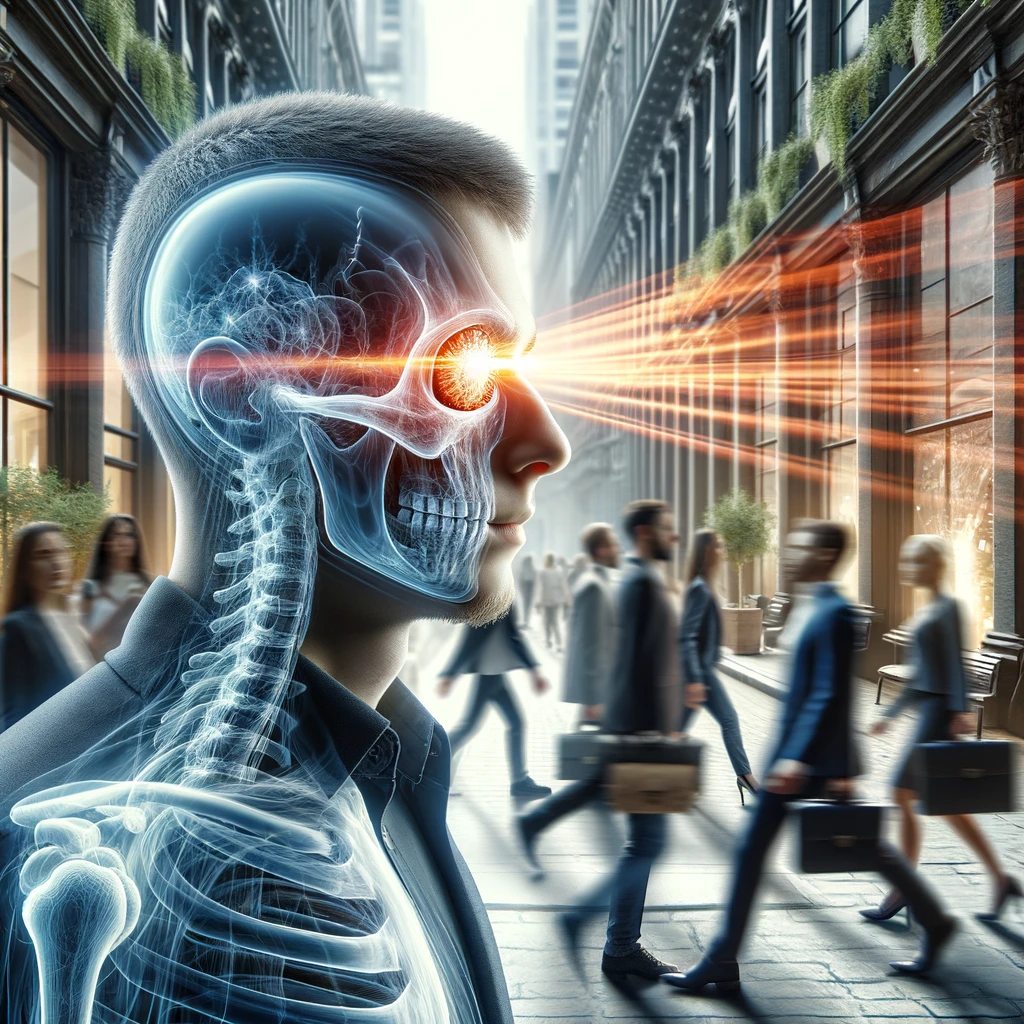
It is crucial for a systems engineer to look beyond what is visually evident regarding a product, a part, or a system for several reasons:
Functionality vs. Appearance: Visual appearance may not always accurately reflect the functionality or performance of a product or system. By looking beyond surface-level aesthetics, engineers can focus on understanding the underlying mechanisms, components, and interactions that drive functionality and performance.
Hidden Defects or Weaknesses: Visual inspection alone may not reveal hidden defects, weaknesses, or vulnerabilities in a product or system. Engineers need to delve deeper into the design, materials, and manufacturing processes to identify potential issues that may affect reliability, safety, or usability.
Complexity and Interdependencies: Many products and systems are complex, comprising numerous interconnected components and subsystems. Visual inspection may provide only a partial view of the overall complexity and interdependencies. Engineers must analyze the system holistically to understand how each component contributes to the system’s behavior and performance.
Lifecycle Considerations: A product or system’s lifecycle extends beyond its initial design and manufacturing stages. Engineers need to consider factors such as maintenance, repair, and end-of-life disposal. By looking beyond visual appearances, engineers can design products and systems that are durable, sustainable, and cost-effective throughout their lifecycle.
User Experience and Usability: Visual appearance is just one aspect of the user experience. Engineers must consider other factors such as ergonomics, accessibility, and intuitive operation to ensure that products and systems meet user needs and expectations effectively.
Regulatory and Compliance Requirements: Visual inspection may not reveal whether a product or system complies with regulatory standards or industry requirements. Engineers must conduct comprehensive assessments and testing to verify compliance and ensure that products and systems meet legal and safety standards.
Innovation and Improvement Opportunities: By looking beyond what is visually evident, engineers can identify opportunities for innovation, optimization, and improvement. This may involve exploring alternative materials, technologies, or design approaches that enhance performance, efficiency, or functionality.
In summary, looking beyond what is visually evident is essential for systems engineers to ensure the functionality, reliability, safety, and usability of products and systems. By adopting a comprehensive and multidimensional approach to analysis and design, engineers can address hidden issues, optimize performance, and drive continuous improvement throughout the product lifecycle.
Can you identify the truth from a lie?

Being able to identify truth from deceit in human interactions is indeed comparable in importance to a systems engineer’s ability to identify a defective product. Here’s how:
Trust and Reliability: In both cases, trust and reliability are crucial factors. Just as a defective product can lead to malfunction or failure, deception in human interactions can lead to broken relationships, misunderstandings, or harm. Both situations undermine trust and compromise the integrity of the system or interaction.
Risk Management: Identifying deceit in human interactions and defects in products involves managing risk. A systems engineer must assess the risk posed by a defective product to determine the potential impact on safety, performance, or reputation. Similarly, recognizing deceit in human interactions allows individuals to mitigate risks associated with dishonesty, manipulation, or betrayal.
Problem Solving and Resolution: Identifying defects in products and deceit in human interactions requires problem-solving skills. A systems engineer must diagnose the root cause of a defect and implement corrective measures to resolve the issue. Similarly, detecting deceit in human interactions necessitates understanding motives, addressing underlying issues, and finding solutions to restore trust and integrity.
Quality Assurance: Just as a systems engineer ensures the quality of products by identifying and addressing defects, individuals in human interactions uphold ethical standards by detecting and confronting deceit. Both processes involve maintaining standards of excellence and accountability to ensure the integrity and reliability of the system or interaction.
Communication and Transparency: Clear communication and transparency are essential in both cases. A systems engineer communicates findings about defective products transparently to stakeholders to facilitate informed decision-making. Similarly, individuals in human interactions promote honesty and transparency to foster trust and mutual understanding.
Ethical Considerations: Both scenarios involve ethical considerations. A systems engineer must adhere to ethical principles and industry standards in addressing defects and ensuring product safety. Similarly, individuals in human interactions must uphold ethical values such as honesty, integrity, and respect for others to maintain trust and integrity in relationships.
Continuous Improvement: Identifying defects in products and deceit in human interactions drives continuous improvement. A systems engineer uses feedback from defect identification to refine processes, enhance product quality, and prevent future issues. Similarly, individuals learn from experiences of deceit to develop better judgment, communication skills, and trust-building strategies in future interactions.
In summary, the ability to identify truth from deceit in human interactions is comparable in importance to a systems engineer’s ability to identify defective products. Both require trust and reliability, risk management, problem-solving skills, quality assurance, communication and transparency, ethical considerations, and a commitment to continuous improvement to ensure the integrity and effectiveness of the system or interaction.
Detecting Lies

Detecting if a person is lying can be challenging, but there are several common signs and behaviors that may indicate deception. It’s important to note that these signs are not foolproof and should be considered in conjunction with other contextual factors. Here are some ways to tell if a person may be lying to you:
Inconsistent Stories: One of the most telling signs of deception is inconsistency in the person’s story. If their account of events changes or contradicts previous statements, it may indicate that they are not telling the truth.
Avoiding Eye Contact: While it’s not always a reliable indicator, avoiding eye contact can sometimes be a sign of deception. However, some people may maintain eye contact even when lying, so this should be considered alongside other behaviors.
Body Language: Certain body language cues, such as fidgeting, nervousness, or defensive postures, may indicate that a person is uncomfortable or anxious about lying. However, these behaviors can also be caused by other factors, so it’s essential to look for clusters of behaviors rather than relying on individual cues.
Speech Patterns: Changes in speech patterns, such as speaking more slowly or hesitantly, using overly formal language, or repeating phrases, may suggest that a person is struggling to fabricate a story or remember details.
Lack of Detail: When someone is lying, they may provide vague or evasive answers to questions rather than offering specific details. They may also avoid answering certain questions altogether or try to change the subject.
Microexpressions: Microexpressions are fleeting facial expressions that occur involuntarily and can reveal a person’s true emotions. While difficult to detect, trained observers may be able to spot microexpressions that contradict the person’s verbal statements.
Baseline Behavior: Comparing the person’s behavior when they are telling the truth to their behavior when they may be lying can be helpful. Look for deviations from their usual demeanor, such as unusual nervousness or defensiveness.
Intuition: Sometimes, our instincts or gut feelings can provide valuable insights into whether someone is lying. Pay attention to your intuition, but also be aware of potential biases or preconceptions that may influence your judgment.
It’s essential to approach the detection of lying with caution and avoid jumping to conclusions based on isolated behaviors. Instead, consider multiple factors and look for patterns or inconsistencies that may indicate deception. Additionally, it’s essential to maintain open communication and address concerns directly and respectfully if you suspect someone may be lying.
Comparable to X-Ray Vision?
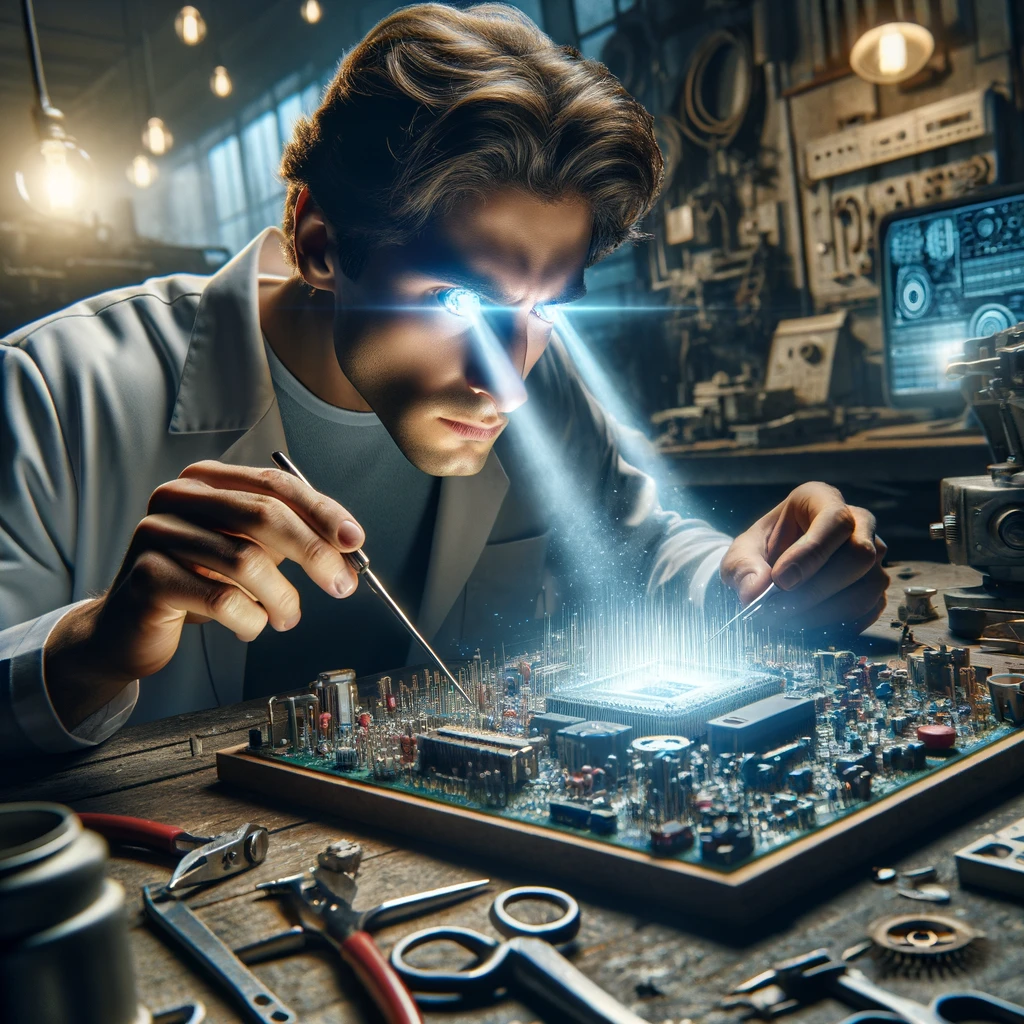
Developing critical thinking and detective-like skills can indeed equip a person with a metaphorical “x-ray vision” that enables them to penetrate superficial layers and identify truth in various contexts. Here’s how:
Analytical Skills: Like a detective scrutinizing evidence, critical thinkers carefully analyze information, scrutinize details, and evaluate sources to discern fact from fiction. They question assumptions, identify logical fallacies, and seek coherence and consistency in arguments, enabling them to uncover hidden truths beneath the surface.
Observational Skills: Just as detectives keenly observe their surroundings for clues, critical thinkers observe behaviors, body language, and patterns of communication to uncover underlying motives, intentions, and truths. They pay attention to subtle cues and inconsistencies that may reveal hidden agendas or deceptive practices.
Research Skills: Critical thinkers employ research skills akin to detective work, gathering evidence, conducting interviews, and cross-referencing sources to corroborate information and validate claims. They delve into primary and secondary sources, critically evaluate information for reliability and credibility, and follow leads to uncover deeper insights and truths.
Problem-Solving Skills: Like detectives piecing together clues to solve a mystery, critical thinkers apply problem-solving skills to unravel complex issues and uncover underlying truths. They break down problems into manageable components, consider multiple perspectives, and employ logic and reasoning to arrive at well-informed conclusions.
Interrogation Skills: Critical thinkers engage in thoughtful questioning and probing to extract information and uncover hidden truths. They ask probing questions, challenge assumptions, and push for clarity and transparency in communication, revealing underlying motives, biases, or inconsistencies that may obscure the truth.
Skepticism and Open-Mindedness: Critical thinkers balance skepticism with open-mindedness, maintaining a healthy degree of skepticism towards claims and assertions while remaining receptive to new evidence and perspectives. They approach information with a critical eye, but they also remain open to revising their beliefs in light of new information or compelling arguments.
Ethical Considerations: Like ethical detectives, critical thinkers adhere to ethical principles and moral values in their pursuit of truth. They prioritize honesty, integrity, and fairness, avoiding biases and prejudices that may distort their judgment or compromise their objectivity.
In summary, developing critical thinking and detective-like skills equips a person with the ability to see beyond surface appearances and identify truth through careful analysis, observation, research, problem-solving, interrogation, skepticism, open-mindedness, and ethical considerations. By cultivating these skills, individuals can develop a metaphorical “x-ray vision” that enables them to penetrate layers of deception and discern truth in various aspects of life.

